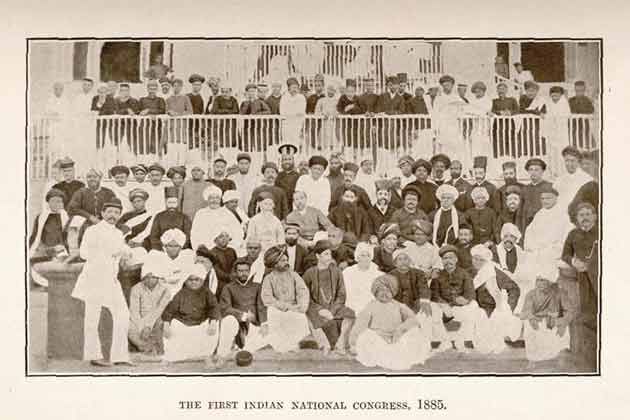
The Indian National Movement, which aimed at achieving independence from British rule, was fueled by several factors.
1.Three key reasons for INM
1. Economic Exploitation by the British:
Drain of Wealth: The British economic policies were designed to benefit Britain at the expense of India. The heavy taxation, exploitation of resources, and drain of wealth from India to Britain led to widespread poverty and economic distress among Indians.
Industrial Decline: Traditional Indian industries, such as textiles, faced severe competition from British manufactured goods, leading to their decline and the resultant unemployment and economic hardship for Indian artisans and workers.
2. Social and Cultural Revival:
Cultural Renaissance: The 19th century witnessed a cultural renaissance in India with the emergence of social reformers like Raja Ram Mohan Roy, Swami Vivekananda, and Dayananda Saraswati. They advocated for social reforms, education, and revival of Indian cultural pride, which fostered a sense of nationalism.
Western Education: The spread of Western education among Indians led to the rise of a new educated middle class. This class became aware of democratic ideals and rights and began to challenge British authority and demand self-governance.
3. Political Discontent and Nationalist Movements:
Repressive Policies: The repressive measures and racial discrimination practised by the British authorities created widespread resentment. Events such as the partition of Bengal in 1905, the Rowlatt Act, and the Jallianwala Bagh massacre intensified anti-British sentiments.
Formation of Indian National Congress: The establishment of the Indian National Congress (INC) in 1885 provided a platform for Indians to voice their grievances and demand political reforms. The INC played a crucial role in mobilising public opinion and organising nationalist activities.
These factors collectively contributed to the rise of the Indian National Movement, which ultimately led to India's independence in 1947.
TOPIC 6.1 THE INDIAN NATIONAL CONGRESS
The National Conference in 1883, decided to invite prominent public men and associations to discuss questions on general concern.
Indian National Union—1884 was formed by AO Hume.
The National Conference and the Indian National Union merged to form the Indian National Congress in 1885.
The first meeting of INC was organised by AO Hume at Gokuldas Tejpal Sanskrit College on 28th December, 1885 in Bombay. AO Hume was a retired British Civil Servant. Meeting was presided over by Womesh Chandra Bonnerjee and attended by 72 delegates.
It was the first organised expression of the Indian National Movement on an all India scale. In 1886, the delegates to Congress became 436.
The venue of the first meeting was Pune but it was changed to Bombay due to the Outbreak of Cholera in Pune.
Kadambini Ganguly was the first woman graduate of Calcutta University to address the Congress Session in 1889.
Safety Valve Theory British historians argue that Hume’s main purpose was to provide a safety valve to the growing discontent among the educated Indians.
Opposition to Congress By Syed Ahmed Khan, Raja Shiva Prasad of Banaras and Lord Dufferin (then Viceroy).
List of the first five presidents of the Indian National Congress and the venues of the sessions they presided over:
Womesh Chunder Bonnerjee
Session: 1885 (First Session)
Venue: Bombay (now Mumbai)
Dadabhai Naoroji
Session: 1886 (Second Session)
Venue: Calcutta (now Kolkata)
Badruddin Tyabji
Session: 1887 (Third Session)
Venue: Madras (now Chennai)
George Yule
Session: 1888 (Fourth Session)
Venue: Allahabad (now Prayagraj)
William Wedderburn
Session: 1889 (Fifth Session)
Venue: Bombay (now Mumbai)
Phases of INC -Objectives and Methods of Work
1.Moderate Phase, (1885-1905)
Development and consolidation of feelings of national unity irrespective of race, caste, religion or province.
Peaceful constitutional agitations, prayer and petitions were the instruments of work.
They succeeded in passing the Indian Councils Act of 1892, which allowed some members to be indirectly elected by Indians, but keeping the official majority intact.
Moderate Leaders
AO Hume, DB Naoroji, Badruddin Tayabji, MG Ranade, WC Banerjee, SN Banerjee, Pherozeshah Mehta, C Shankaran Nalyar, MM Malviya, VS Shrinivas Shastri, Tej Bahadur Sapru. GK Gokhale, Anand Mohan Bose, E Dinesh Wacha, Ras Bihari Ghosh, Mohanlal Ghosh, P Anand Charlu, CY Chintamani, RC Dutt, Subrahmanya Aiyer, KT Telang, Madhusudan Das, Rahuntulla M Sayani.
They worked to create a strong public opinion to arouse consciousness and national spirit. They persuaded the British Government and British public opinion to introduce reforms in India.
2.Extremist Phase (1905-17)
Cause for the Rise of Extremists
Dissatisfaction with the methods and achievements of moderates.
Growing consciousness about the exploitative character of British rule. Loss of Britain in the Boer wars (1899-1902) demolished the myth ft. whiteman supremacy.
Reactionary policies of Curzon University Act (1904), Indian Official Secrets Act (1904) to restrict freedom of press and partition of Bengal.
Extremists gave the idea of India’s independence the central place in India’s politics.
Quick Digest
1st President of INC WCBonnerjee
1st Woman President Annie Besant
1st Muslim President Badruddin Tayabji
1st English President George Yule
1st Indian Women President SarojiniNaidu
Gandhi became President 1924, Belgaum
Jawaharlal Nehru became President 1929, Lahore
Subhash Bose becamePresident 1938, Haripura President
JB Kriplani INC President at Independence
Methods of the Extremists
Promotion of Swadeshi and Boycott of foreign goods. Non-Co-operation with Britishers (Passive Resistance). Extremist leaders- Lala Lajpat Rai, Bal Gangadhar Tilak, Bipin Chandra Pal, Sir
Aurobindo Ghosh, Chakravarti Bose. T Prakasam and Chidambaram Pillat.They want to take the movement outside Bengal.
